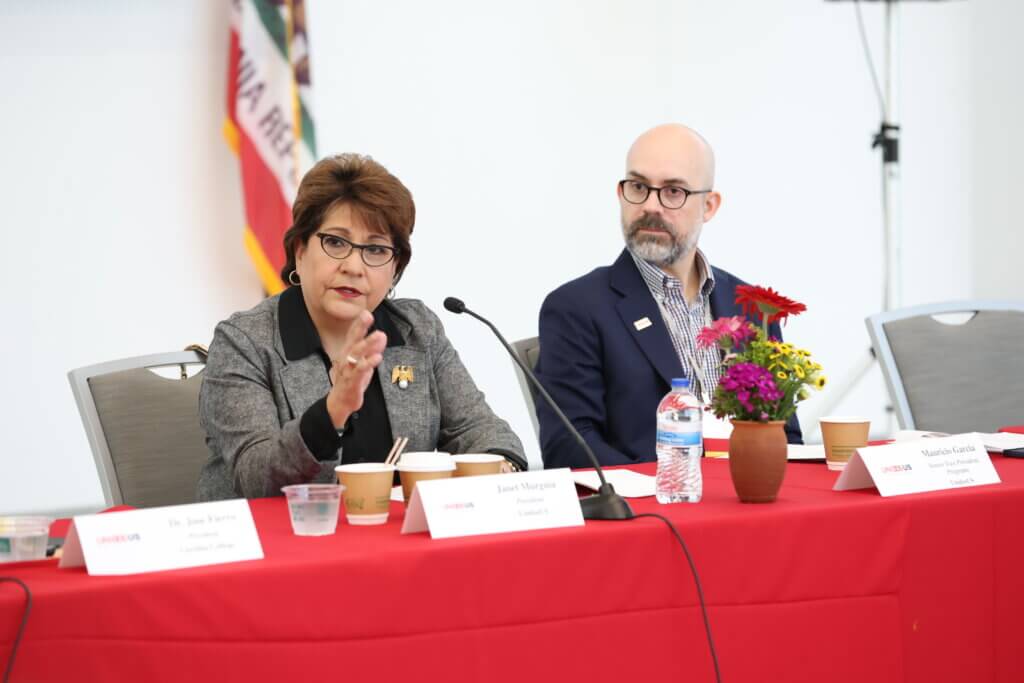The new and improved FAFSA has proven to be anything but that up to now. Here’s how to deal while the government works out its kinks.
Last year, Oklahoma educator Manuel Medina was excited to learn that the U.S. government would be revamping its Free Application for Federal Student Aid (FAFSA). The old form, the one he used to apply for his own financial aid in college, was long and cumbersome. This new form would streamline the way he engages the students in his college and career readiness class, many of whom are first generation or come from homes where their parents are undocumented.
– Author Julienne Gage is a former UnidosUS Senior Web Content Manager who now serves the organization as a consultant.
That was his hope anyway. By the time the online form went live in early January, it was already three months behind its expected schedule, and even then the government was working out glitches that left millions of applicants with online black outs or waiting for help on the site’s chat. Plus, some mixed-status families have expressed concern that the new form requires people without Social Security Numbers to go through a separate online process to receive identity verification for their parents to obtain an FSA ID, of which many students are simply unable to complete due to technical errors. As such, students must go through yet another process to validate their parents’ identity, starting with contacting a call-center to simply receive a case number.
Then, on January 23 came an even bigger glitch. That’s the day the U.S. Department of Education acknowledged it needed to make adjustments for inflation so that it wouldn’t cost students and their families an additional $1.8 billion. The student aid calculations in the new forms do not currently reflect the high inflation that families have been experiencing. Without that fix, many applicants would get a lesser award, but the fix added to the delay in sending FAFSA information to universities—meaning that school officials won’t receive the information they need until March. This has a domino effect that will cause delays at each institution’s financial aid departments and can jeopardize scholarships for students that use the information from the FAFSA as a benchmark for awards.
“Who knows how many students are going to slip through,” Medina added, noting that these delays and requirements may stop or at least deter many from following through with this year’s college plans.
Had students been able to start filling out the FAFSA in October when they were applying for college, they might have gotten their financial aid offers along with their acceptance letters so that they could make informed decisions about their college choice. In January, less than a million high school seniors had filed an application, a nearly 45% drop in applicants from this time last year, according to the National College Attainment Network. As of mid-February, the Department of Education had about five million FAFSA filings overall, which is half of its usual amount. Communities with a high percentage of low-income and students of color have seen the worst drops, at 54% and 53% respectively. That has created a log jam for both the government and the nearly 4,000 U.S. colleges and universities developing the financial aid offers. It’s also a direct contradiction to what the Department of Education promised in a statement from December 15.
“Students and families will have ample time to complete the 2024-2025 FAFSA, and do not need to rush to fill out the form immediately when the soft launch period opens,” it read.
On February 21, the Department promised a permanent fix to the errors affecting mixed-status families by the first-half in March. In the meantime, a temporary workaround has been provided for students that must have an earlier submission date to be eligible for critical state or institutional scholarships. The Department of Education cautions however, only those whose deadlines come before the availability of the permanent fix should use the workaround, as they’ll be required to make corrections to fully complete the FAFSA once such ability becomes available. Furthermore, the Department announced that by the end of February, such students unable to complete the online verification of their parents identity will automatically receive a case number, reducing the need to rely on backed-up call centers.
How Latinos are disproportionately impacted
These hurdles may prove especially difficult for Latino students. According to a 2019 UnidosUS fact sheet, Latino student enrollment has been on the rise since 2000, and as of 2016, 74% of them were applying for financial aid. A 2020 UnidosUS fact sheet notes that an estimated 70%of Latino students are first-generation college goers. A 2019 UnidosUS executive summary on immigration estimates that between 4.1 and and 5.7 million U.S.-citizen children live with an undocumented parent. There are an estimated 700,000 people protected under the DACA program, but their parents are not. And then there’s the question of how last year’s Supreme Court decision to gut affirmative action will impact the acceptance rate for Latinos at selective universities.
“While we applaud the effort to streamline a notoriously difficult application for federal financial aid, we are concerned that these combined factors may significantly lower enrollment rates for historically underserved students,” said UnidosUS Higher Education Policy Analyst Magin Sanchez.
Better FAFSA, better funding?
With the new FAFSA, applicants must identify both primary and secondary contributors, and the form recommends citing the main contributor as the one making the most income. This has become a point of contention for many applicants because that person may not actually live with the applicant or be contributing to their education. At the same time, the new FAFSA does not account, as it did in the past, for other siblings for whom caregivers would be providing for on that income.
A few weeks prior to announcing the decision to adjust for inflation, the Department of Education instructional site suggested that applicants “contact the school where you plan to attend and explain and document the change in income.”
While cumbersome, students with deadlines for scholarships that require FAFSA may want to do just that, UnidosUS’s education team says.
All of these factors are expected to shorten the time students will have to decide which school they want to attend or can afford to go to, or whether it’s even feasible to go this year, since most schools require students to make a decision about an admission offer by early May. In response to such shortened deadlines, some schools have delayed their decision day, a practice that UnidosUS encourages all institutions to do to ensure equitable admissions amidst the current delays facing students.
Troubleshooting this year’s form and the financial aid process
Medina says it’s not that there weren’t delays before the new FAFSA, it’s just that they’ve never been as big, plentiful, or far reaching as they are now.
“Last year (2022) I worked with some students who applied for FAFSA in October, November, and December, and it took a while for their aid to get processed. They might have been selected to be one of the students who had to get verified, or they might (have needed) to send in additional documentation. This delayed their decisions because they were waiting to see which school could offer the most aid,” he said, adding that it can also impact their applications to other grants and scholarships.
While the U.S. government figures out how to rectify the roadblocks to what was supposed to be a quicker, easier, FAFSA, Medina suggested students, families, educators, and advocates revisit some of the methods he learned when he was a student enrolled in the U.S. government’s official college readiness support program TRIO. They’re lessons he used for himself but also shared with others. Before becoming a college and career readiness teacher, he spent his high school and college years volunteering to help his peers fill out their FAFSAs, a technique that can be beneficial to all involved.
He says applicants should consider tapping into those exact programs, which often hold FAFSA nights, and if you can’t find a program or event like that in your area, create one. It’s easier to fill out the FAFSA in a group setting where everyone can pitch in to figure it out. It also helps to reach out to college and career readiness teachers in the area, and contact the financial aid offices of the institutions students hope to attend.
In mid-February, the Department of Education offered $50 million to help under-sourced non-profit schools strengthen their financial aid services with the new FAFSA. The department expects to administer those funds to the Education Credit Management Corporation. From there, the funds are to be given to at least two non-profit organizations. The first two are the National Association of Student Financial Aid Administrators and the Partnership for Education Advancement, which would help to hire and train financial aid professionals for the purpose of getting these institutions up to speed. The department is looking into providing funding for NASFAA and ED Advancement, both institutions that serve underserved communities.
Medina has always encouraged students to apply to institutions in their region, especially community colleges, which have a reputation for readily lending this type of support, and that might be a good option for students caught up in the uncertainty of the current financial aid debacle.
“As a teacher, I would have my students fill out applications for local colleges because you never know,” said Medina, noting that even in years when the FAFSA process isn’t so delayed, “life happens.”
When Congress passed the FAFSA Simplification Act on Dec. 27, 2020, the bipartisan effort represented a significant overhaul of the federal student aid system. UnidosUS had hoped for a smoother rollout of the new FAFSA and is now urging the U.S. Department of Education to fix the problems as quickly as possible.
“No doubt this has been a clunky rollout, but we also cannot lose sight of the potential of the new FAFSA to streamline the application process, expand access to financial aid, and improve the user experience over the long term,” says UnidosUS Education Policy Project Director Amalia Chamorro. “The form actually reduced the number of questions from 103 to as little as 18 questions, and it increased the number of students who are eligible for Pell grants by 200,000. These are not minor improvements and should not be overlooked.”
“This year’s FAFSA process raises many concerns, but we at UnidosUS are just as invested in the implementation of the new FAFSA as we were in advocating for its passage. We are closely monitoring this issue as it unfolds and will continue to inform the Latino community to ensure that they are able to navigate the financial aid process successfully in school years to come.” As the department works toward permanent fixes and new information becomes available, UnidosUS will continue to keep its Network informed on the latest developments.





